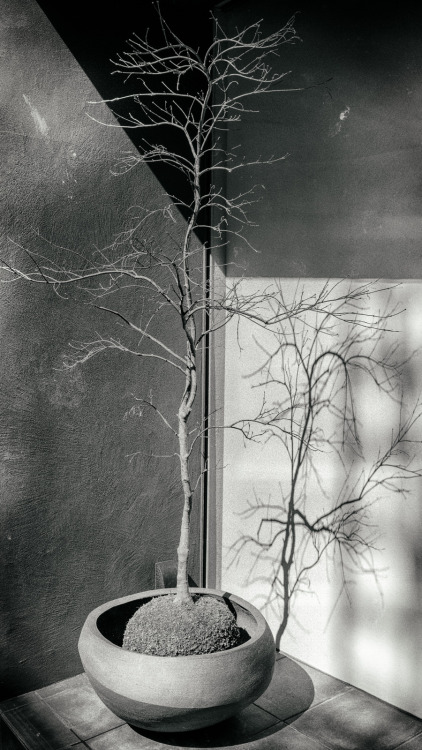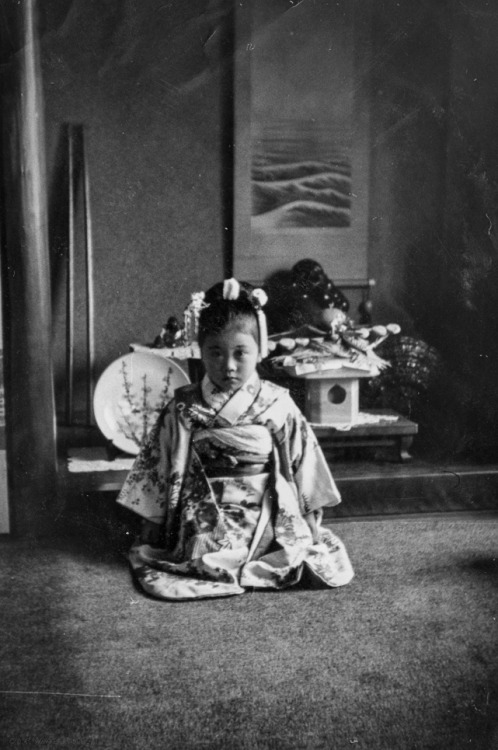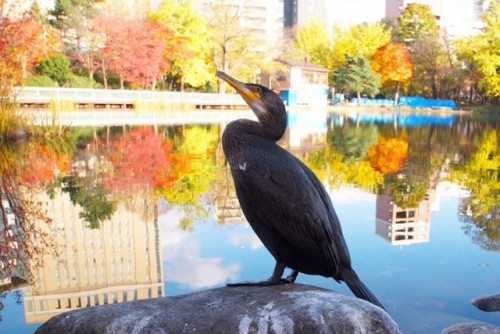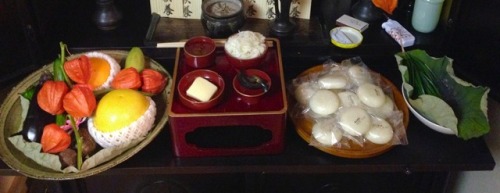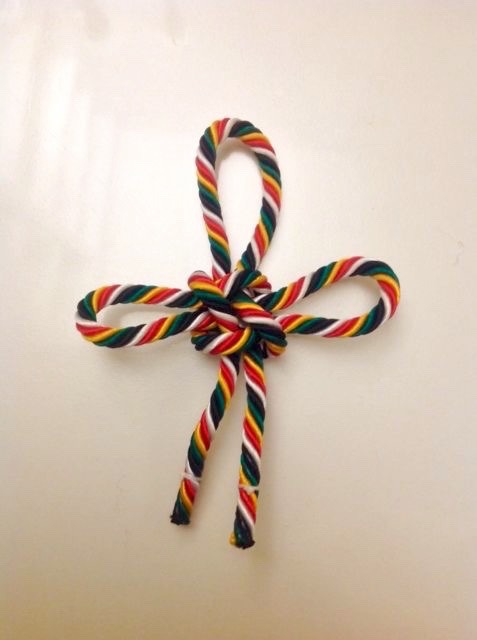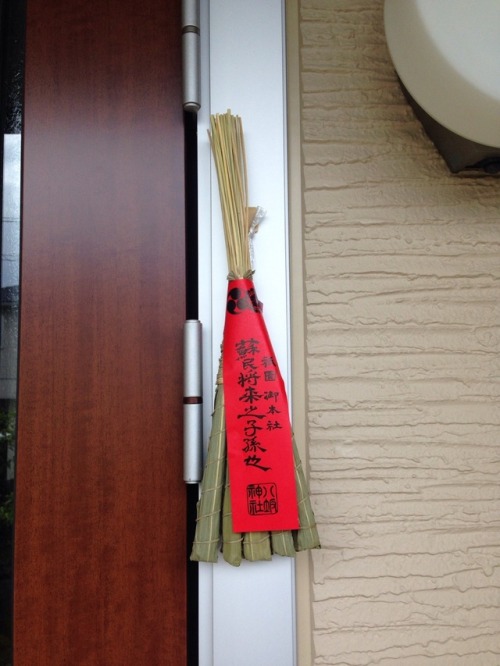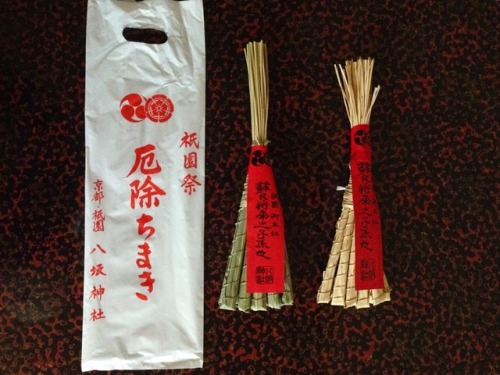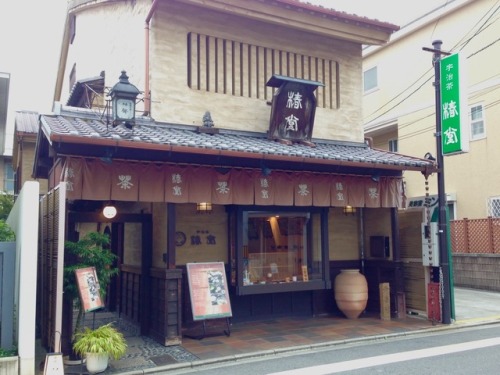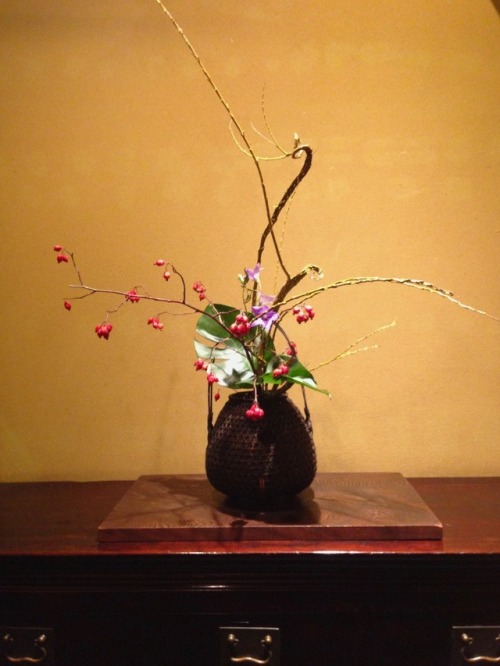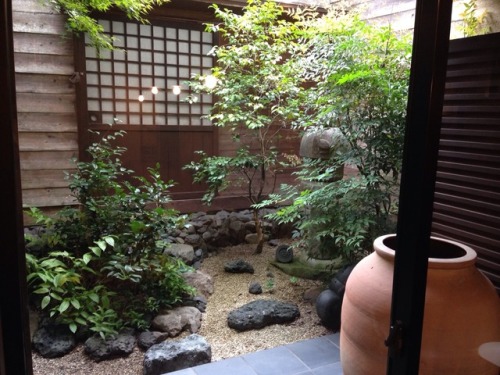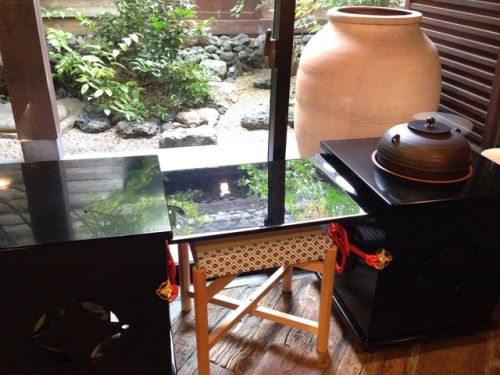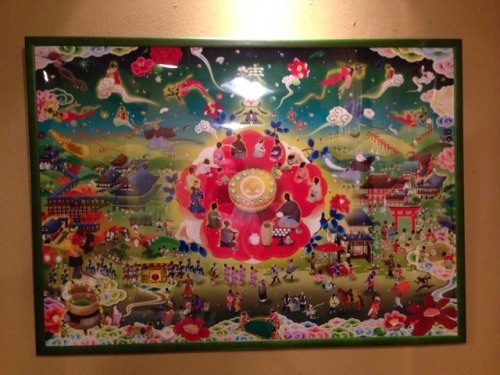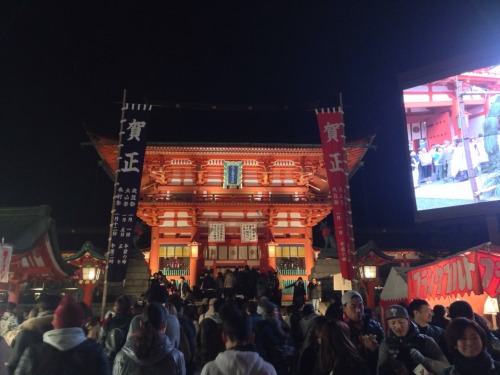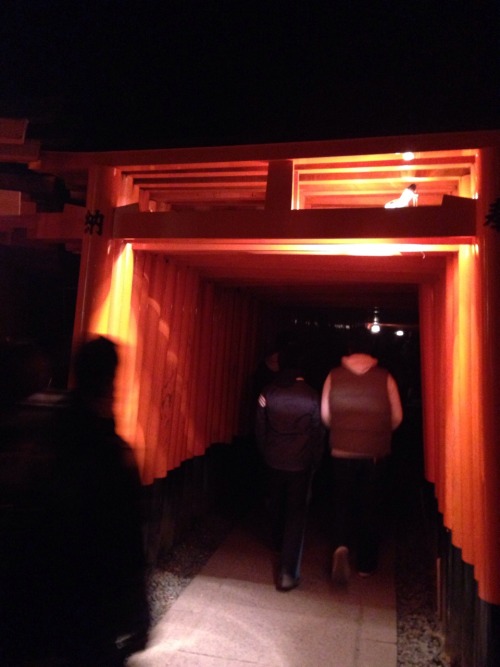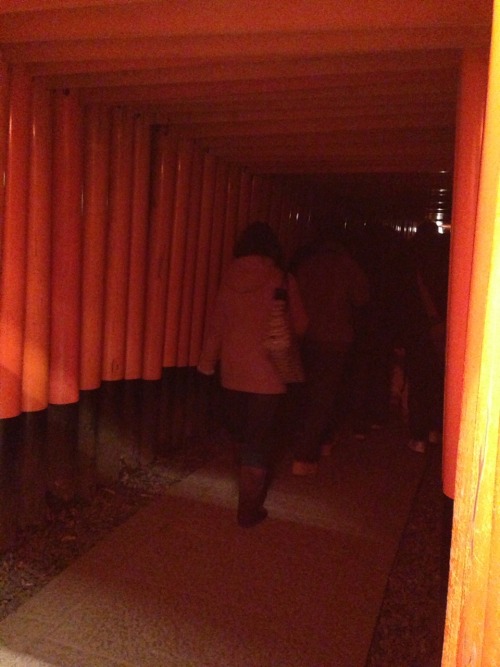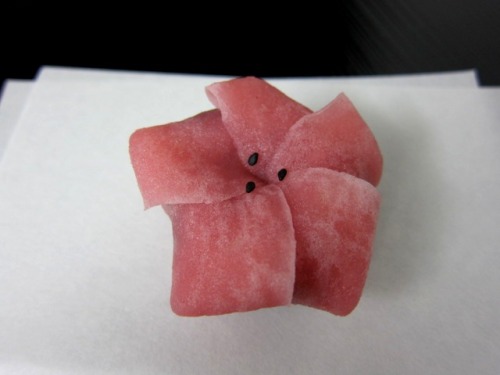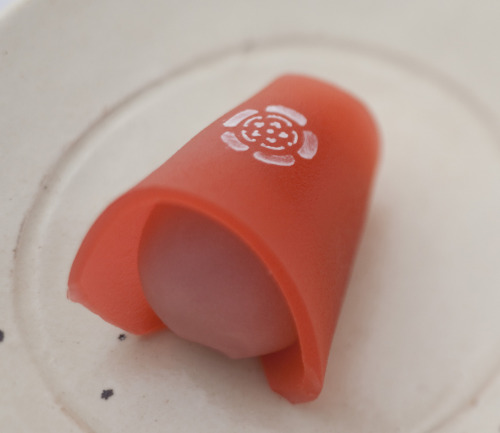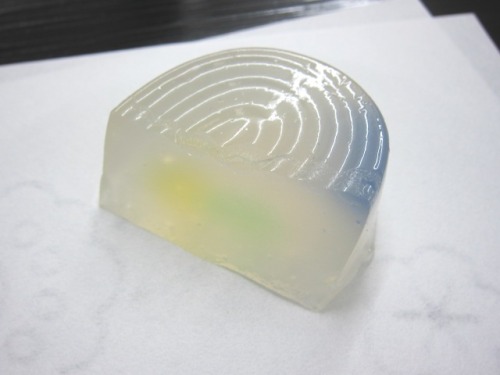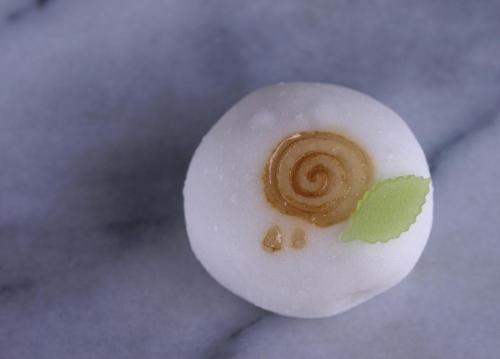#japanese tradition
New Years at Grandma’s Place, mid-late 60s
Photo of little Miss Sasamoto by Mama Sasamoto with Papa’s “German” camera.
(Upper-middle class to upper class, Showa era.)
The glossy fan-shaped object just barely visible in the rear, is a“sarunokoshikake,” which is a type of mushroom (polyporaceae). This one was huge and was apparently very valuable at the time and more so today. I have been trying to research it, but the most I have learned is that It was used as an ornament throughout the year. It was also used in traditional medicine.
In the background on the short table in the tokonomaiskagamimochi, a traditional Japanese New Year decoration with two rice “cakes” (mochi) and a bitter orange on top. This one also has a skewer of dried persimmons on top of it. The dark object on top of all and in front of the scroll is daikokuten, the god of wealth. The scroll, kakejiku, varied by season. The fan shaped object on the right is not related to New Years, but is a sort of dried mushroom (sarunokoshikake) used as an expensive decoration.
Photo of by Mama Sasamoto, taken sometime in the mid 1960s at grandma’s house in Odawara, Kanagawa Prefecture.
(Scanned from an old print.)
Post link
Cormorant Fishing - 5 Spots To Witness A Treasured Fishing Tradition
Ukai (cormorant fishing) is a traditional technique of catching river fish with the help of cormorants. Three rivers in Japan are said to be preserving this old custom - Nagara River in Gifu, Hiji River in Ehime and Mikuma River in Oita.
Post link
It’s Obon here in Kyoto, ancestors’ homecoming (or somewhat sober Halloween?). Obon is one of the two important events for Japanese in a year (the other is new year celebration), which often leads to family reunion for the living, too.
In Kyoto, people invite their ancestors’ spirits into home in the evening of August 12 with “muka'e'bi [moo-kah-eh-bee]” (literally meaning “inviting/welcoming fire”), and send ancestors back to the next world at the night of August 16 with “Gozan Okuribi [oh-coo-ree-bee]”, (“bonfires on five mountains for sending ancestors back”), according to lunar calendar. For Obon, people clean up their family graves beforehand, and confort and offer their hospitality to ancestors such as with foods and pray with monk’s sutras at home.
To invite ancestors, we do a little ritual “muka'e'bi” at home: burn dry hemp stems in front of the house, fire three stick incenses, and set it at the family’s Buddhist altar. Ancestors’ spirits are believed to “ride on” the special smoke of the incense, come into the house, and settle at the family’s Buddhist altar in a denser or more concrete form than usual (I’m not died and don’t know how it is actually, though).
We serve “omuka'e somen”, or “welcome somen noodle (angel-hair udon, so to speak)” for the first night. While Obon, vegetables and fruits, Chinese lantern plant, water on a lotus leaf with a sprig of Koya prodocarp (“Koya maki”/高野槙), mochi and/or dango (sweet dumplings), and sugar starch snacks (“rakugan”) are also displayed. Vegetarian dishes and steamed rice are served everyday until they leave. The dishes served are kept in the fridge and taken to the temple a family belongs to with other vegetables just when Obon ends (to send the foods with ancestors’ spirits precisely, or if you eat them, it’s believed you would get ill. Dishes and vegetables served during Obon are simply for the repose of the dead).
Since the Obon customs differ by region and denomination, I totally don’t know other styles. No “Bon dance” or “summer festival” is held in my neighborhood. No making horse and ox figures with vegetables and toothpicks. I’ve seen them only on TV. The case explained above is only of a certain family in Kyoto.
By the way, what about spirits who don’t have any descendants? …It’s said no home to go and loitering here and there. So people give a little service for the benefit of suffering spirits as well as avoid going to sea or river in fear of evil spirits during Obon.
Obon
http://www.japan-guide.com/e/e2286.html
https://en.m.wikipedia.org/wiki/Bon_Festival
Gozan Okuribi (mountain bonfire)
https://www.jnto.go.jp/eng/spot/festival/gozanokuribi.html
お盆の迎え火におがらを炊く。京都では8月12日の夕暮れに家の外で迎え火を焚いて先祖を家へ招き入れ、16日の夜の五山送り火で送り返す。お盆の最初の夜はお迎え素麺でもてなす。ちなみに野菜と爪楊枝で馬や牛を作ったりしない。近所では盆踊りも夏祭りもない。TVでしか見たことがない。関東では同じ宗派でも仏壇に水塔婆を立てないと聞いた。色々土地によって違うらしい。
Post link
The five-colored-rope bracelet which was given at Hasedera temple in Nara for the occasion of Eleven-face Kannon (a Bodhisattva) special viewing (usually hidden). I have not known what to do with the rugged, easily slackening rope loop, showing a tie to the humongous Kannon, but recently found that Hasedera introduces with footage untying and remaking to agemaki-musubi (a decorative rope work with supernatural intention) for a talisman.
As I went into agemaki knotting, I knew it’s been used for quite a long time (since the tumultuous period—the mid-third century to the seventh century) and there two types exist: hito-gata (人型) to protect against evils and dangers, and iri-gata (入型) to invite good luck and happiness (the 人 and 入 kanji letters are according to how two sides crossing of the knot looks like. 型 means shape). Whereas hito-gata is often used for samurai’s helmets and armors (protection), iri-gata is used for bridal costume and furnishings (happiness). I also found Hasedera’s footage showed hito-gata (against evil), though shrines use iri-gata (good luck), so it turns out shrine and temple are using opposite-direction knotting—I don’t know what it means.
I just simply followed Hasedera’s iri-gata knotting (protection) since the rope should be connected to Buddha, not god (kami). Then I removed silk scarf from my Coach bag and tied the rope to the handle. …Pretty stands out unexpectedly. I could even say traditional something of Spain or Italy (something’s what?).
Anyway, the five-colored-rope bracelet is effectively utilized and now I’m protected. Great.
How to knot agemaki-musubi (hito-gata/for protection)—Hasedera’s footage
http://www.hasedera.or.jp/sp/promotion/1/blog_detail.html?key=entry&value=254
How to knot agemaki-musubi (iri-gata/for good luck) and actual use at shrine—by a Shinto priest with pictures
http://blog.tennjinn.net/-how%20to-縄・紐の結び方/あげまき結びの結び方
Hasedera Temple (of Nara prefecture, Japan Visitor)
http://www.japanvisitor.com/japan-temples-shrines/hasedera-nara
奈良の長谷寺の特別拝観でもらった五色線の腕輪。十一面観音様との結縁紐だが、ゴツくてすぐ緩むので持て余していたところ、長谷寺のHPで「ほどいてあげまき結びにしてお守りにすると宜しい」と動画で紹介しているのを知った。
調べてみるとあげまき結びは相当古くからある結び方(古墳時代以降)で、厄除の人型と招福の入型の2種類があることを知った(人・入は結目の2辺の交わりの形に由来)。人型は侍の鎧兜に使われるのに対し(厄除)、入型は花嫁衣裳や調度品に使われる(招福)。また、長谷寺の動画では人型(厄除)になっているのに対し、神社の説明では入型(招福)が使われていた。ということは、寺と神社で逆方向の結び方を採用していることになる。これってどういうことなんだろう? 謎だ。
仏さんとの結縁紐(けちえんひも)なので、自分は素直に長谷寺の厄除・入型結びに従ってみた。それでコーチのカバンに巻いていたシルクスカーフを外し、付けてみた。・・・思いのほか派手である。スペインかイタリアの伝統的な何かっぽく見えないこともない(何かって何よ?)
ともあれ五色線の腕輪は有効活用され、私は加護を得た。素晴らしからんや。
あげまき結び(人型、厄除)ー長谷寺の動画
http://www.hasedera.or.jp/sp/promotion/1/blog_detail.html?key=entry&value=254
あげまき結び(入型、招福)と実際の使用風景ー神主さんの説明図
http://blog.tennjinn.net/-how%20to-縄・紐の結び方/あげまき結びの結び方
総角結び(あげまきむすび)の解説
http://yuunet.jp/demo/pg137.html
長谷寺(奈良県)
https://ja.m.wikipedia.org/wiki/長谷寺
http://www.hasedera.or.jp/sp/
Post link
Lunch at “Nishiki Agaru” near Nishiki Market, Kyoto. Nicely arranged tiny colorful cups called “nozoki” are so cute, which I never use at home (…too many to wash, you know).
The restaurant was a renovated Machiya, traditional merchant’s house, and had a beautiful small inner garden deep-inside with fresh green of Japanese maple, which we enjoyed just next to our seats. It was good to make a reservation earlier.
Kyomachiya Nishiki Agaru (Japanese)
https://www.google.co.jp/amp/s/s.tabelog.com/kyoto/A2601/A260201/26025527/top_amp/
You can also bring foods you bought at Nishiki Market in (They will serve them on dish). Better to make reservations especially for weekend lunch.
Machiya
https://en.m.wikipedia.org/wiki/Machiya
Kyoto’s Machiya is especially called “Kyomachiya”.
Nishiki Market (japan-guide.com)
http://www.japan-guide.com/e/e3931.html
錦市場ちかくの「錦上ル」で昼ごはん。きれいに並べられたのぞきが可愛いらしい、が、家では全然使わない(洗い物が増えるしな;)。
細長い町家の奥座敷には紅葉の青がきれいな坪庭。早くに予約しておいて良かった。
京町家 錦上ル
http://nishikiagaru.jp
京町家
https://ja.m.wikipedia.org/wiki/京町家
Post link
Yasaka shrine’s chimaki, a charm for warding off evil (made of only rice reeds and no rice cake inside unlike sweets sold in May). It’s deadly awful, hot and wet July and the arrival of Gion Festival in Kyoto.
Few days ago after celebrating my mom’s birthday at some ryotei (authentic Japanese restaurant) around Higashiyama, I dropped in Yasaka shrine for receiving this year’s new chimaki (you use the word “receive (from god)” instead of “buy” in Japanese for charms and amulets of shrine). Yasaka shrine’s chimaki is sold during the entire month of July and relatively easy to obtain compared to Yama and Hoko floats’, though every float, built and exhibited on the street, starts selling its original chimaki only a few days before the parade day and sells out quickly.
Chimaki will be hanged out at the porch or the gate. The protection lasts for a year and you will take it back to any shrine after a year: since it’s a holy item Shinto priests burn old charms with praying. Appreciate for the protection of the past one year, and wish for another one-year mercy.
Chimaki of Gion Festival
https://www2.city.kyoto.lg.jp/koho/eng/preview/40.html
Strip color and letters differ by float. Yasaka shrine’s is to ward off evil but every chimaki’s mercy differs by float, such as for romantic love, study, and money profit.
Folklore on Somin Shorai
https://en.m.wikipedia.org/wiki/Somin_Shorai
The red strip on Yasaka shrine’s chimaki reads “A Somin Shorai’s descendant”.
Gion Festival
https://en.m.wikipedia.org/wiki/Gion_Matsuri
八阪神社の厄除ちまき(お菓子ではなく中は空)。時は蒸暑くも不快極まりない七月、祇園祭の到来である。
先日東山の料亭で母の誕生日を祝った後、八阪神社へ寄り今年のちまきを受けた(ちまきは「買う」ではなく「受ける」「授かる」)。街中に建つ祇園祭の山鉾のちまきは巡行日の2、3日前から売りに出され、すぐに売切れてしまうが、八阪神社のちまきは山鉾と違い7月中売られており手に入りやすい。
ちまきは玄関の外か門の前に掲げる。御利益は一年間。1年過ぎたらお焚き上げのため神社へ返す。一年間の御守護に感謝。また一年間御加護が有りますように。
ちまきとは
http://www.kyotodeasobo.com/gion/chimaki/
八坂神社の厄除けである蘇民将来の謂われについて。八阪神社のちまきには「蘇民将来子孫也」と書かれた赤い紙が付いている。また山鉾ごとのちまきの御利益一覧表など。縁結びの保昌山(ほうしょうやま)は女子に大人気で毎年速攻売り切れる。筆者も恋する女子友に購入に付き合わされたことが(長蛇の列に並んだ)。
祇園祭
https://ja.m.wikipedia.org/wiki/祇園祭
https://www.kyokanko.or.jp/gion/gyoji.html
Post link
Japanese tea room Chikusei by Tsubakido, at Fushimi, Kyoto. A purveyor to Fushimi Inari Taisha (shrine). Tea, sweets, the interior design, everything’s great. Surely wanna visit again.
Tsubaki-do 椿堂
http://www.tsubakido.kyoto
Only in Japanese, but has a nice tea company film. Tranquil and worth to watch. “Tsubaki” means camellia FYI.
京都伏見の椿堂竹聲。伏見稲荷大社御用達。煎茶、スイーツ、室礼、どれも良い。また訪れたい。
Post link
My first visit of the year to a shrine happened to be Fushimi Inari taisha, Kyoto, which draws the most worshippers in western Japan. It was on our ways home from Kyoto station after countdown concert.
I found a huge, unfamiliar screen by the two-storied gate and it was quite surreal like “Blade Runner” or “Ghost in the Shell”. Is it temporary only for new-year three days?
The approach seemed not crowded as much as new-year daytime, yet before the main hall it was totally stuck and took long time. Further, it was sooooo freezing at three o'clock in the morning to go through thousands of torii gates, back of the main hall, and I decided without hesitation to indulge myself with oden and hot sake as I sooon as I saw at the inner sanctuary. I realized it really worked. Really.
After that, I dropped by the local shrine (ujigami-san: the guardian god of the community) in my neighborhood, obtained new “ofuda (talisman or amulet for home to reach a certain god)” to replace (we do once a year) and got home at five. I have never visited shrines in such early hours of January first. I’ve seen such people only on TV. Unusual fun experience. And I knew myself so tired.
Fushimi Inari shrine
http://www.japan-guide.com/e/e3915.html
https://en.m.wikipedia.org/wiki/Fushimi_Inari-taisha
If it’s daytime, I recommend hiking up to the top of Inari yama mountain (233m above sea level, takes one-two hours to reach as taking photos, reading signboard’s English explanations and having a break at tea house). You will see many little shrines “tsuka” and thousands of torii as enjoying beautiful mountain air and greens. Actually, Inari god (harvest god) was not enshrined at the foot originally and it’s said it still resides in the mountain. So when you go up, be careful of your words and behavior; believe or not, it’s been said the spiritual subordinates here “kitsune (foxes)” to Inari god are very strict to the culpable while they are the most capable and powerful among other kinds.
初詣はたまたま伏見稲荷大社になった。京都駅のカウントダウンライブ後、ちょうど帰宅途中にあったのだ。
行くと楼門前に見慣れない巨大なスクリーンがあり、「ブレードランナー」か「攻殻機動隊」みたいにシュールなことになっていた。あれは正月三ヶ日限定なんだろうか。
参道は正月の昼間ほどには混んでいなかったが、本殿の前は流石に満杯でびたっと詰まっていた。さらに真夜中3時の本殿裏の千本鳥居は無茶苦茶寒くて、奥社奉拝所(おくのやしろほうはいしょ)ではもう、いつもなら食べないおでんと熱燗を目にするや即決で食べていいことに。寒いときのおでんと熱燗はあったまる。それはもう本当に。
その後は家の近所の氏神さんへお詣りして、新しいお札を貰って、朝5時に帰ってきた。夜中のうちに初詣を2件も済ませたのは生まれて初めてだ。そういうのはTVでしか観たことがなかった。なかなか珍しい経験をした。そしてやっばりものすごく眠かった。
伏見稲荷大社
https://ja.m.wikipedia.org/wiki/伏見稲荷大社
昼間であれば稲荷山の頂上まで登って参拝するのがおすすめ(海抜233m、写真を撮ったり立て看板の説明を読んだりお茶屋で休憩したりしながら登って頂上まで1〜2時間)。元々平安時代の頃は麓に社殿はなく稲荷神は山に居ると言われている。道中千本鳥居を始め様々なお社("お塚")があり、空気も清く景色も美しい。地元伏見では頂上の一宮へお参りすることを「お山(やま)する」と言う。・・・お山では狐さん(←厳しい)が見ているのでマナーには注意。
Post link
Traditional Japanese Wedding Dress by Wow Japanese
Brides host their wedding ceremony at a shrine wear a shiromuku, a white wedding kimono, which represents “the purity and sacred of the bride,” and a wataboshi, a white hat (acts as a veil), is often worn, too.
While western style of wedding and bridal gowns have become quite popular among Japanese brides over the years, Shinto Wedding remains significant as:
Shinto Wedding is often held on a small scale involving the couple, immediate family members and close friends. So not only it is more convenient but more affordable to hold a reasonably extravagant traditional Japanese style wedding.
Post link
Meguro River. Before and during Cherry Blossoms.


